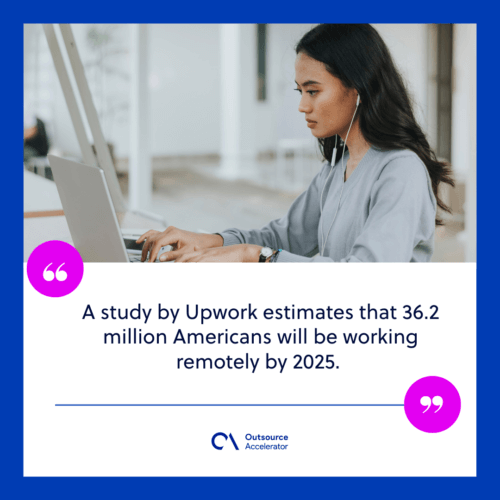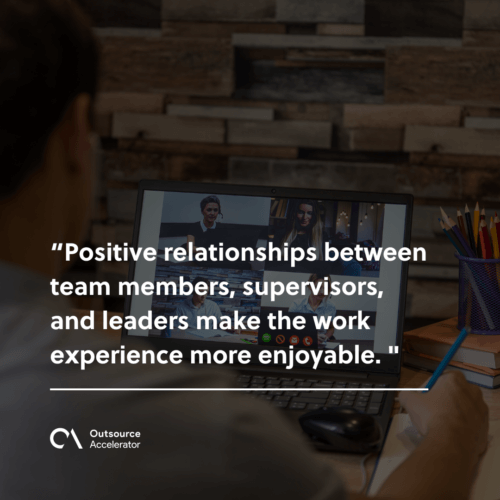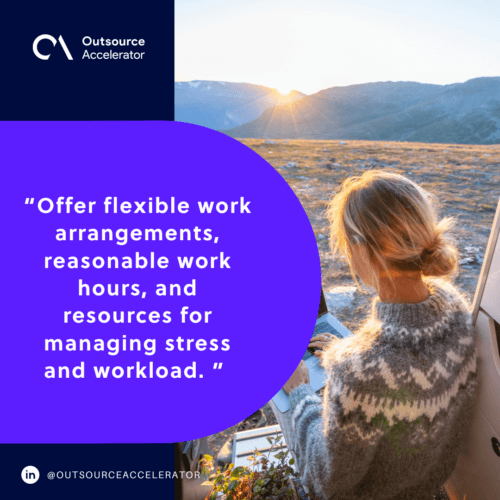The essentials of a good work environment

The work environment is more than just the physical space where employees perform their daily tasks. It’s a dynamic ecosystem that influences productivity, job satisfaction, and overall well-being.
It’s where employees spend a significant chunk of their time, and a positive work environment can help them thrive.
On the other hand, a negative work environment can lead to stress, burnout, and other health issues.
In the 493rd episode of the Outsource Accelerator Podcast, Deployed’s Chief Commercial Officer Angela McDonald touched on how a good work setup benefits your staff.
7 Types of work environments
Each type of work environment brings its own strengths and capabilities.
Here are the seven main types of work environments:
1. Traditional office work environment
In the traditional work environment, employees work in a designated office space during standard business hours. It typically includes fixed workstations or cubicles and operates within a hierarchical organizational structure.
Employees benefit from having clear routines and schedules, which help maintain a separation between work and home life.
Face-to-face interactions are the norm, and employees have easy access to office resources and support staff.
This is the setup that Angela prefers for Deployed’s outsourced staff, but the company also supports other types.
“We’ve probably got about 60 percent of the workforce working full-time in the office, 20 percent are hybrid, and another 20 percent are fully remote.
But in the office, there’s more structure [and] a sense of community.”
2. Remote work environment
This type of work environment allows employees to work from locations outside a traditional office, often from home.
It relies on digital tools to stay connected and allows for flexible hours. This provides employees with greater autonomy and independence.
A study by Upwork estimates that 36.2 million Americans will be working remotely by 2025.

3. Hybrid work environment
The hybrid work environment combines elements of traditional office and remote work setups.
It’s a flexible arrangement that allows for adaptable schedules and the use of both physical office space and digital tools. Policies and practices are designed to support both remote and in-office work.
Angela says that she “likes the hybrid models. I think they can work quite well if they’re implemented properly.
It becomes a benefit, [and] if things aren’t going well or there’s an issue at home, we can get them in the offices.”
4. Coworking space environment
Coworking spaces offer shared office environments where individuals from different companies or freelancers work alongside each other. They also allow opportunities to network with professionals from various fields.
Coworking spaces are cost-effective alternatives to traditional offices, offering flexible membership options.
5. Creative work environment
Creative work environments aim to foster creativity and innovation. They’re commonly found in industries such as advertising, design, and tech startups.
These environments feature open and flexible workspaces and an informal and relaxed atmosphere – which encourages brainstorming and creative thinking.
6. High-stress work environment
This work environment is typical in industries like finance, healthcare, and emergency services.
A high-stress work environment is mainly characterized by:
- Intense and fast-paced work demands
- High levels of responsibility and accountability
- Frequent and tight deadlines, and
- Urgent tasks
7. Inclusive work environment
Inclusive work environments prioritize diversity and inclusion, creating a supportive and respectful atmosphere for all employees.
DEI policies and practices, supportive networks, and employee resource groups define this arrangement.
Factors to consider when choosing a work environment
When choosing a work environment, it’s important to consider various factors that can impact your overall job satisfaction, well-being, and career growth.
According to Angela, Deployed aims to get the best out of its staff and is therefore willing to be flexible in its work environment.
“We want them to succeed, so it really depends on the role.
If it’s a challenging one, [then] we definitely need to look at additional options for flexible working environments. [But] when our clients start, all the handholding and visibility in a structured place makes all the difference.”
Here are some key factors to consider:
Company culture
The culture consists of the values, beliefs, and behaviors that shape the work atmosphere and how employees interact.
Consider whether your company culture aligns with the values that the brand promotes (including your own personal ones).
Work-life balance
The ability to balance professional responsibilities with personal life is crucial for overall well-being.
Environments that offer flexible work hours, remote work options, or hybrid models contribute to this.
Physical workspace
For an office layout, consider the physical elements that impact employees’ welfare. The comfort and functionality of the physical workspace can significantly impact productivity and job satisfaction.
Commute and location
The geographic location of the work environment and the daily commute involved are major factors. A manageable commute plays a large role in work-life balance and overall contentment.
Workplace relationships
Assess the team dynamics and the level of camaraderie among colleagues. Positive relationships between team members, supervisors, and leaders make the work experience more enjoyable.
Angela says that their current arrangement enables this.
“It gives us a chance to build a relationship with the staff. [And] when you’re in a structured environment, you naturally perform better.”

Compensation and benefits
Evaluate the compensation package and benefits you offer within your work environment.
These include base salary, health insurance, retirement benefits, vacation time, and other perks like wellness programs or even tuition reimbursement.
Purpose and impact
Employees like to derive meaning and fulfillment from their work. Ensure that you provide them with work that has the potential to positively impact society, the environment, or the industry.
5 Ways to create a positive work environment
Creating a positive work environment is essential for fostering employee satisfaction, well-being, and productivity.
Here are some key strategies to achieve this:
1. Foster open communication
Encourage open and transparent communication among employees, supervisors, and leadership. Create an open-door policy where employees feel comfortable sharing their ideas, concerns, and feedback.
Regular check-ins, both one-on-one and in team meetings, help ensure that everyone is aligned and feels heard.
Angela also briefly covers this, especially when it comes to new recruits.
“Communication has to be quite consistent in the early days with the staff. They need to know if they are doing it right or wrong.”
2. Cultivate a supportive culture
A supportive culture fosters a sense of teamwork and shared purpose. It also values diversity, inclusion, respect, and collaboration.
Organize team-building activities and social events to strengthen relationships and camaraderie. These can even be done during work operations through cross-functional projects.
Establish mentorship programs where veteran employees can guide and support less experienced colleagues.
3. Provide growth opportunities
Offering opportunities for professional development is vital when creating a good work environment.
Provide training programs, workshops, and courses to help employees gain new skills and advance their careers.
4. Promote work-life balance
The work environment should enable a healthy work-life balance. Offer flexible work arrangements, reasonable work hours, and resources for managing stress and workload.

5. Recognize and appreciate employees
Acknowledge and appreciate employees’ efforts and contributions. Celebrate achievements regularly through awards, public recognition in meetings, or personalized appreciation programs.
These help encourage continuous effort and dedication among your employees.
Looking back on Deployed’s achievements, Angela says that while the work is management-intensive, it’s also rewarding.
“I was speaking about the knock-on effect to get that sense of pride in the team. They might think they’re just doing HR, or sales, or recruitment, but actually one can’t happen without the other.”
You may browse Deployed’s services and solutions via their website.






 Independent
Independent




